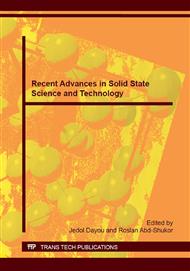p.27
p.33
p.39
p.45
p.59
p.67
p.73
p.79
p.85
Transport Characteristics of Secondary Charged Particles Resulting from High Energy Neutron in Silicon
Abstract:
Silicon is always the dominant semiconductor material of the modern semiconductor industry. This is as silicon can retain its semiconductor characteristics even at a higher temperature while the other semiconductor materials can't. However, when a silicon device is exposed to a flux of energetic radiation or particles, the effects from the radiation and the induced secondary particles can cause several degradation of the device performance. For the purpose of investigate the resultant effects from the bombardment of neutrons and the behavior of secondary charged particles in the silicon model, the neutron displacement defect was measured in situ and then followed by the simulation based on Monte Carlo method. The bombardment of neutron in the silicon model produce at least three secondary particles, which are alpha ˸α˹ particles, proton (p) particles and silicon recoil atoms, through the reactions of ˸̾˼α˹˼˰˸̾˼̀˹˰and neutron scattering respectively. The kinetic energy and range of these charged particles are different among themselves, and thus the probability of hitting and degradation effects in the silicon materials are varies. The simulation calculation showed that ˸̾˼α˹˰reaction induced soft error cross section of about 8.7 x 10-14 cm2 and for recoil atoms, it is about 2.9 x 10-15 cm2. There was no error of the silicon device configuration induced by proton particles until 1010 n/cm2.neutron fluence. It can be concluded that the largest portion of error in the silicon model is induced by the secondary alpha ˸α˹ particles.
Info:
Periodical:
Pages:
79-84
Citation:
Online since:
June 2015
Authors:
Price:
Сopyright:
© 2015 Trans Tech Publications Ltd. All Rights Reserved
Share:
Citation:


